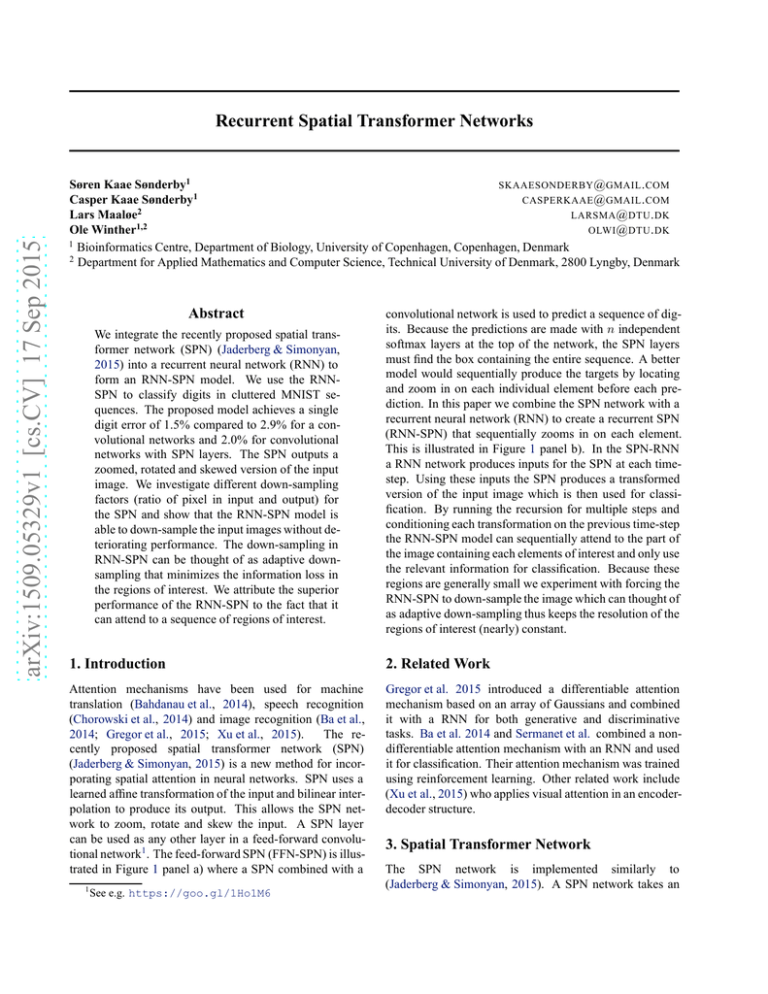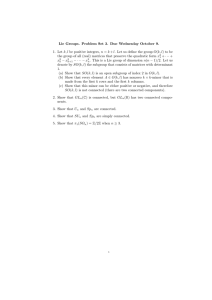Recurrent Spatial Transformer Networks
advertisement

arXiv:1509.05329v1 [cs.CV] 17 Sep 2015
Recurrent Spatial Transformer Networks
Søren Kaae Sønderby1
SKAAESONDERBY @ GMAIL . COM
Casper Kaae Sønderby1
CASPERKAAE @ GMAIL . COM
Lars Maaløe2
LARSMA @ DTU . DK
Ole Winther1,2
OLWI @ DTU . DK
1
Bioinformatics Centre, Department of Biology, University of Copenhagen, Copenhagen, Denmark
2
Department for Applied Mathematics and Computer Science, Technical University of Denmark, 2800 Lyngby, Denmark
Abstract
We integrate the recently proposed spatial transformer network (SPN) (Jaderberg & Simonyan,
2015) into a recurrent neural network (RNN) to
form an RNN-SPN model. We use the RNNSPN to classify digits in cluttered MNIST sequences. The proposed model achieves a single
digit error of 1.5% compared to 2.9% for a convolutional networks and 2.0% for convolutional
networks with SPN layers. The SPN outputs a
zoomed, rotated and skewed version of the input
image. We investigate different down-sampling
factors (ratio of pixel in input and output) for
the SPN and show that the RNN-SPN model is
able to down-sample the input images without deteriorating performance. The down-sampling in
RNN-SPN can be thought of as adaptive downsampling that minimizes the information loss in
the regions of interest. We attribute the superior
performance of the RNN-SPN to the fact that it
can attend to a sequence of regions of interest.
convolutional network is used to predict a sequence of digits. Because the predictions are made with n independent
softmax layers at the top of the network, the SPN layers
must find the box containing the entire sequence. A better
model would sequentially produce the targets by locating
and zoom in on each individual element before each prediction. In this paper we combine the SPN network with a
recurrent neural network (RNN) to create a recurrent SPN
(RNN-SPN) that sequentially zooms in on each element.
This is illustrated in Figure 1 panel b). In the SPN-RNN
a RNN network produces inputs for the SPN at each timestep. Using these inputs the SPN produces a transformed
version of the input image which is then used for classification. By running the recursion for multiple steps and
conditioning each transformation on the previous time-step
the RNN-SPN model can sequentially attend to the part of
the image containing each elements of interest and only use
the relevant information for classification. Because these
regions are generally small we experiment with forcing the
RNN-SPN to down-sample the image which can thought of
as adaptive down-sampling thus keeps the resolution of the
regions of interest (nearly) constant.
1. Introduction
2. Related Work
Attention mechanisms have been used for machine
translation (Bahdanau et al., 2014), speech recognition
(Chorowski et al., 2014) and image recognition (Ba et al.,
2014; Gregor et al., 2015; Xu et al., 2015).
The recently proposed spatial transformer network (SPN)
(Jaderberg & Simonyan, 2015) is a new method for incorporating spatial attention in neural networks. SPN uses a
learned affine transformation of the input and bilinear interpolation to produce its output. This allows the SPN network to zoom, rotate and skew the input. A SPN layer
can be used as any other layer in a feed-forward convolutional network1 . The feed-forward SPN (FFN-SPN) is illustrated in Figure 1 panel a) where a SPN combined with a
Gregor et al. 2015 introduced a differentiable attention
mechanism based on an array of Gaussians and combined
it with a RNN for both generative and discriminative
tasks. Ba et al. 2014 and Sermanet et al. combined a nondifferentiable attention mechanism with an RNN and used
it for classification. Their attention mechanism was trained
using reinforcement learning. Other related work include
(Xu et al., 2015) who applies visual attention in an encoderdecoder structure.
1
See e.g. https://goo.gl/1Ho1M6
3. Spatial Transformer Network
The SPN network is implemented similarly to
(Jaderberg & Simonyan, 2015). A SPN network takes an
Transformer network
Figure 1. SPN networks for predicting the sequence 723 from an image. a) A FFN-SPN network attend to the entire sequence (blue box).
The digits are classified by three separate softmax layers at the top of the network. Because the network cannot zoom in on individual
digits in the sequence all digits are classified from the same image crop. b) A RNN-SPN where the transformation is predicted with an
RNN. This allows the model to create a separate crop for each digit. Each crop (indicated with blue numbers) is then passed through the
same classification network. The structure enables the model to zoom in on each individual digit.
image or a feature map from a convolutional network as
input. An affine transformation and bilinear interpolation
is then applied to the input to produce the output of the
SPN. The affine transformation allows zoom, rotation and
skew of the input. The parameters of the transformation
are predicted using a localization network floc :
θ
floc (I) = Aθ = 1
θ4
θ2
θ5
θ3
,
θ6
(1)
where I is the input to the SPN with shape [H × W × C]
(height, width, channels) and matrix Aθ specifies the affine
transformation. The affine transformation is applied on a
mesh grid G ∈ Rh×w :
G ={(y1 , x1 ), (y1 , x2 ), ...(y2 , x1 ), (y2 , x2 ),
...(yw , xh−1 ), (yh , xw )}.
(2)
where w and h does not need to be equal to H and W . G
is illustrated in Figure 2 panel a). The grid is laid out such
that (y1 , x1 ) = (−1, −1) and (yh , xw ) = (+1, +1) with
the points in-between spaced equally. The affine transformation is applied to G to produce an image S which tells
how to select points from I and map them back onto G:
yi
Sij = Aθ xj
1
(3)
where we have augmented each point with a 1. Since the
mapped points in S does not correspond exactly to one
pixel in I bilinear interpolation is used to interpolate each
point in S. The sub-gradients for the bilinear interpolation are defined and we can use standard backpropagation
through the transformation to learn the parameters in floc .
The sampling process is illustrated in Figure 2 where panel
a) illustrates G and panel b) illustrates S after we have applied the transformation.
3.1. Down-sampling
We can vary the number of sampled points by varying h and
w. Having h and w less than H and W will downsample
the input to the SPN. We specify the down sampling with
d. d larger than 1 will downsample the input. The number
of sampled points form I is:
H ·W
W
H
·
=
.
(4)
npoints =
d
d
d2
For 2D images the sampled points decrease quadratically
with d.
3.2. RNN-SPN
In the original FFN-SPN the localization network is a feedforward convolutional neural network. We modify this
model by letting an RNN predict the transformation matrices such that
c = fconv (I)
rnn
ht = floc
(c, ht−1 )
Aθ = g(ht ).
(5)
(6)
(7)
where fconv is a convolutional network taking I as input and
rnn
creating a feature map c, floc
is an RNN, and g is a FFN.
Here an affine transformation is produced at each time-step
from the hidden state of the RNN. Importantly the affine
transformations are conditioned on the previous transformations through the time dependency of the RNN.
4. Experiments
We test the model on a dataset of sequences of MNIST digits cluttered with noise. The dataset was created by placing
3 random MNIST digits on a canvas of size 100 × 100 pixels. The first digits was placed by randomly sampling an
Transformer network
Figure 2. a) The sampling grid G of equally spaced sampling points. We set y1 and x1 to −1 and yh , xw to +1. b) A recurrent SPN
is able to zoom in on each element in the sequence. c) Bilinear transformation will interpolate the red cross by calculating a weighted
average of the four nearest pixels. The operation is differentiable.
y position on the canvas. The x positions were randomly
sampled subject to the entire sequence must fit the canvas
and the digits are non-overlapping. Subsequent digits are
placed by following a slope sampled from ±45◦. Finally
the images are cluttered by randomly placing 8 patches of
size 9 × 9 pixels sampled from the original MNIST digits.
For the test, validation and training sets we sample from
the corresponding set in the original MNIST dataset. We
create 60000 examples for training, 10000 for validation,
and 10000 for testing2 . Figure 3 shows examples of the
generated sequences.
As a baseline model we trained a FNN-SPN with the SPN
layer following immediately after the input. The classification network had 4 layers of conv-maxpool-dropout layers
followed by a fully connected layer with 400 units and finally a separate softmax layer for each position in the sequence. The convolutional layers had 96 filters with size
3 × 3 and rectified linear units were used for nonlinearity
in both the convolutional and fully connected layers. For
comparison we further train a purely convolutional network
similar to the classification network used in the FFN-SPN.
The RNN-SPN use a gated recurrent unit (GRU)
(Chung et al., 2014) with 256 units. The GRU is run for
3 time steps. At each time step the GRU unit use c as input.
We apply a linear layer to convert ht into Atθ . The RNNSPN is followed by a classification convolutional network
similar to the network used in the FFN-SPN model, except
that the convolutional layers only have 32 filters.
In all experiments, the localization networks had 3 layers of
max-pooling convolutional layers. All convolutional layers
had 20 filters with size [3 × 3]. All models were trained
with RMSprop (Tieleman & Hinton, 2012) down-sampling
factors and dropout rates optimized on the validation set.
A complete description of the models can be found in the
2
The script for generating the dataset is available along with
the rest of the code.
Table 1. Per digit error rates on MNIST sequence dataset, d is the
down-sampling factor.
Cluttered MNIST Sequences
Model
Err. (%)
RNN-SPN d=1 1.8
RNN-SPN d=2 1.5
RNN-SPN d=3 1.8
RNN-SPN d=4 2.3
FFN-SPN d=1 4.4
FFN-SPN d=2 2.0
FFN-SPN d=3 2.9
FFN-SPN d=4 5.3
Conv. net.
2.9
Appendix.
The models were implemented using Theano
(Bastien et al., 2012) and Lasagne (Dieleman et al.,
2015). The SPN has been merged into the Lasagne
library3 . Code for models and dataset is released at
https://goo.gl/RspkZy.
5. Results
Table 1 reports the per digit error rates for the tested models.
The RNN-SPN models perform better than both convolutional networks (2.9%) and FFN-SPN networks (2.0%). In
Figure 3 we show where the model attend on three sample
sequences from the test set. The last three columns show
image crops after the affine transformation using a downsampling factor of three. We found that increasing the
down-sampling factor above one encouraged the model to
zoom. When the down-sampling factor is greater than one
we introduce an information bottleneck forcing the model
to zoom in on each digit. The poor performance of the FFN3
Available here: http://goo.gl/kgSk0t
Transformer network
Figure 3. The left column shows three examples of the generated cluttered MNIST sequences. The next column shows where the model
attend when classifying each digit. In the last 3 column we show the image crops that the RNN-SPN uses to classify each digit. The
input sequences are 100 × 100 pixels. Each image crop is 33 × 33 pixels because the model uses a down-sample factor of 3.
SPN convolutional net for high down-sampling values is
explained by the effective decrease in resolution since the
model needs to fit all three digits in the image crop.
Chorowski, Jan, Bahdanau, Dzmitry, Cho, Kyunghyun, and
Bengio, Yoshua. End-to-end Continuous Speech Recognition using Attention-based Recurrent NN: First Results. December 2014.
6. Conclusion
Chung, Junyoung, Gulcehre, Caglar, Cho, KyungHyun,
and Bengio, Yoshua. Empirical Evaluation of Gated Recurrent Neural Networks on Sequence Modeling. arXiv
preprint arXiv:1412.3555, December 2014.
We have shown that the SPN can be combined with an RNN
to classify sequences. Combining RNN and SPN creates
a model that performs better than FFN-SPN for classifying sequences. The RNN-SPN model is able to attend to
each individual element in a sequence, something that the
FFN-SPN network cannot do. The main advantage of the
RNN-SPN model when compared to the DRAW network
(Gregor et al., 2015) is that the SPN attention is faster to
train. Compared with the model of (Mnih et al., 2014) our
model is end-to-end trainable with backpropagation. In this
work we have implemented a simple RNN-SPN model future work include allowing multiple glimpses per digit and
using the current glimpse as input to the RNN network.
References
Ba, Jimmy, Mnih, Volodymyr, and Kavukcuoglu, Koray.
Multiple Object Recognition with Visual Attention. December 2014.
Bahdanau, Dzmitry, Cho, Kyunghyun, and Bengio, Yoshua.
Neural Machine Translation by Jointly Learning to Align
and Translate. September 2014.
Bastien, Frédéric, Lamblin, Pascal, Pascanu, Razvan,
Bergstra, James, Goodfellow, Ian, Bergeron, Arnaud,
Bouchard, Nicolas, Warde-Farley, David, and Bengio,
Yoshua. Theano: new features and speed improvements.
arXiv preprint arXiv:1211.5590, November 2012.
Dieleman, Sander, Schlüter, Jan, Raffel, Colin, Olson, Eben, Sønderby, Søren Kaae, Nouri, Daniel,
Battenberg, Eric, van den Oord, Aäron, and other
contributors. Lasagne: First release., August 2015. URL
http://dx.doi.org/10.5281/zenodo.27878.
Gregor, Karol, Danihelka, Ivo, Graves, Alex, and Wierstra,
Daan. DRAW: A Recurrent Neural Network For Image
Generation. arXiv preprint arXiv:1502.04623, 2015.
Jaderberg, M and Simonyan, K. Spatial Transformer Networks. arXiv preprint arXiv: 1506.02025, 2015.
Mnih, Volodymyr, Heess, Nicolas, Graves, Alex, and
Kavukcuoglu, Koray. Recurrent Models of Visual Attention. June 2014.
Sermanet, Pierre, Frome, Andrea, and Real, Esteban. Attention for Fine-Grained Categorization.
Tieleman, T and Hinton, Geoffrey E. {Lecture 6.5—
RmsProp: Divide the gradient by a running average of
its recent magnitude}, 2012.
Xu, Kelvin, Ba, Jimmy, Kiros, Ryan, Cho, Kyunghyun,
Courville, Aaron, Salakhutdinov, Ruslan, Zemel,
Richard, and Bengio, Yoshua. Show, Attend and Tell:
Transformer network
Neural Image Caption Generation with Visual Attention.
February 2015.
Appendix
6.1. RNN-SPN
6.2. Baseline models
Localisation network
FFN-SPN model
1.
2.
3.
4.
5.
6.
7.
8.
maxpool(2,2)
conv(20@(3,3))
maxpool(2,2)
conv(20@(3,3))
maxpool(2,2)
conv(20@(3,3))
GRU(units=256)
Denselayer(6, linear output)
Classification network
1. SPATIAL TRANSFORMER LAYER (downsample = 1, 3,
4)
2. conv(32@(3,3))
3. maxpool(2,2)
4. dropout(p)
5. conv(32@(3,3))
6. maxpool(2,2)
7. dropout(p)
8. conv(32@(3,3))
9. dropout(p)
10. Dense(256)
11. softmax
In table Table 1 the model are reported at RNN SPN with
an entry for each tested downsample factor.
1.
2.
3.
4.
5.
6.
7.
8.
9.
10.
11.
SPATIAL TRANSFORMER LAYER (downsample = 2.0)
conv(96@(3,3))
maxpool(2,2)
dropout(p)
conv(96@(3,3))
maxpool(2,2)
dropout(p)
conv(96@(3,3))
dropout(p)
Dense(400)
3 × softmax
Localisation network
1.
2.
3.
4.
5.
6.
7.
8.
maxpool(2,2)
conv(20@(3,3))
maxpool(2,2)
conv(20@(3,3))
maxpool(2,2)
conv(20@(3,3))
Denselayer(200)
Denselayer(6, linear output)
This model is reported in Table 1 as the SPN conv. network.
Finally we also trained the classification network from the
FFN-SPN reported as conv. Net in Table 1.


![[Motion 2014_10_M02] Course Recommendations for University Studies Approval—Sept. 29](http://s2.studylib.net/store/data/012060465_1-aab47185195dbd544a4d708bd882f391-300x300.png)
